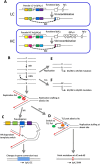Molecular mechanisms of avian immunoglobulin gene diversification and prospect for industrial applications
- PMID: 39346918
- PMCID: PMC11427246
- DOI: 10.3389/fimmu.2024.1453833
Molecular mechanisms of avian immunoglobulin gene diversification and prospect for industrial applications
Abstract
Poultry immunoglobulin genes undergo diversification through homologous recombination (HR) and somatic hypermutation (SHM). Most animals share a similar system in immunoglobulin diversification, with the rare exception that human and murine immunoglobulin genes diversify through V(D)J recombination. Poultry possesses only one functional variable gene for each immunoglobulin heavy (HC) and light chains (LC), with clusters of non-productive pseudogenes upstream. During the B cell development, the functional variable gene is overwritten by sequences from the pseudo-variable genes via a process known as gene conversion (GC), a kind of HR. Point mutations caused in the functional variable gene also contribute to immunoglobulin diversification. This review discusses the latest findings on the molecular mechanisms of antibody gene diversification in poultry, using chickens as a model. Additionally, it will outline how these basic research findings have recently been applied especially in the medical field.
Keywords: DNA damage tolerance; gene conversion; homologous recombination; monoclonal antibody; somatic hypermutation; therapeutic antibody.
Copyright © 2024 Seo, Hirota and Ohta.
Conflict of interest statement
The authors declare that the research was conducted in the absence of any commercial or financial relationships that could be construed as a potential conflict of interest.
Figures


References
-
- Reynaud CA, Anquez V, Grimal H, Weill JC. A hyperconversion mechanism generates the chicken light chain preimmune repertoire(1987). Available online at: http://www.ncbi.nlm.nih.gov/pubmed/3100050 (Accessed August 14, 2013). - PubMed
-
- Reynaud CA, Dahan A, Anquez V, Weill JC. Somatic hyperconversion diversifies the single Vh gene of the chicken with a high incidence in the D region(1989). Available online at: http://www.ncbi.nlm.nih.gov/pubmed/2507167 (Accessed August 14, 2013). - PubMed
Publication types
MeSH terms
Substances
LinkOut - more resources
Full Text Sources
Miscellaneous

